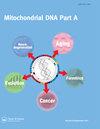Variations in mitochondrial DNA control region among Malay and Chinese subpopulations (sequence 16000–16200)
IF 0.6
4区 生物学
Q4 GENETICS & HEREDITY
引用次数: 2
Abstract
Abstract DNA variations are alterations found in DNA sequence, occurring in both nuclear DNA and mitochondrial DNA. Variations might differ in individual following population, respectively. The aim of this study was to find variations in target sequence of mtDNA (16000–16200) to be used as marker in Malay and Chinese population. A total of 30 buccal swab samples from 20 Malay and 10 Chinese subjects were collected and preserved on FTA card. The FTA card that contained DNA sample was punched to be included into polymerase chain reaction mixture. Amplification was carried out and the products were sequenced. Sequence variations were found in both Malay and Chinese populations. A total of nine variations (16129, 16108, 16162, 16172, 16148, 16127, 16173, 16099 and 16100) were found in Malay population while a total of seven variations (16129, 16104, 16111, 16109, 16164, 16170 and 16136) were found in Chinese population. Nucleotide position 16129 was found as variation in both Malay and Chinese populations. This study implies that np 16129 can be used as a marker for Malaysian population. For further investigation, the length of the target sequence may be increased to obtain more variations that can be used as markers. This will increase the discrimination power of Malaysian population.马来人与华人亚群线粒体DNA控制区差异(序列16000-16200)
DNA变异是在DNA序列中发现的改变,发生在核DNA和线粒体DNA中。变异可能在个体后续人群中有所不同。本研究的目的是寻找马来人和华人mtDNA靶序列(16000-16200)的变异,以作为标记。收集20名马来人、10名华人的口腔拭子样本共30份,保存在FTA卡上。将含有DNA样本的FTA卡片打孔,放入聚合酶链反应混合物中。扩增并对产物进行测序。在马来人与华人族群中均发现序列变异。在马来人群中发现了9个变异(16129、16108、16162、16172、16148、16127、16173、16099和16100),而在华人人群中发现了7个变异(16129、16104、16111、16109、16164、16170和16136)。核苷酸位置16129在马来人与华人群体中均有变异。本研究提示np 16129可以作为马来西亚人口的标记。为了进一步研究,可以增加目标序列的长度,以获得更多可作为标记的变异。这将增加马来西亚人的歧视权力。
本文章由计算机程序翻译,如有差异,请以英文原文为准。
求助全文
约1分钟内获得全文
求助全文
来源期刊

Mitochondrial Dna Part a
Biochemistry, Genetics and Molecular Biology-Genetics
CiteScore
3.00
自引率
0.00%
发文量
6
期刊介绍:
Mitochondrial DNA Part A publishes original high-quality manuscripts on physical, chemical, and biochemical aspects of mtDNA and proteins involved in mtDNA metabolism, and/or interactions. Manuscripts on cytosolic and extracellular mtDNA, and on dysfunction caused by alterations in mtDNA integrity as well as methodological papers detailing novel approaches for mtDNA manipulation in vitro and in vivo are welcome. Descriptive papers on DNA sequences from mitochondrial genomes, and also analytical papers in the areas of population genetics, phylogenetics and human evolution that use mitochondrial DNA as a source of evidence for studies will be considered for publication. The Journal also considers manuscripts that examine population genetic and systematic theory that specifically address the use of mitochondrial DNA sequences, as well as papers that discuss the utility of mitochondrial DNA information in medical studies and in human evolutionary biology.
 求助内容:
求助内容: 应助结果提醒方式:
应助结果提醒方式:


